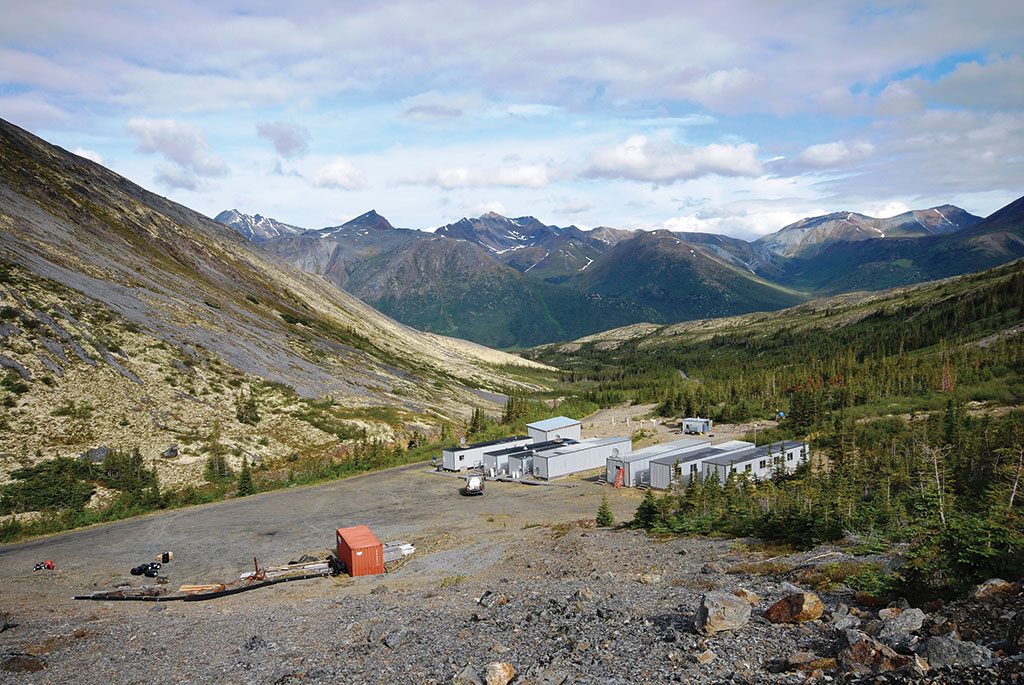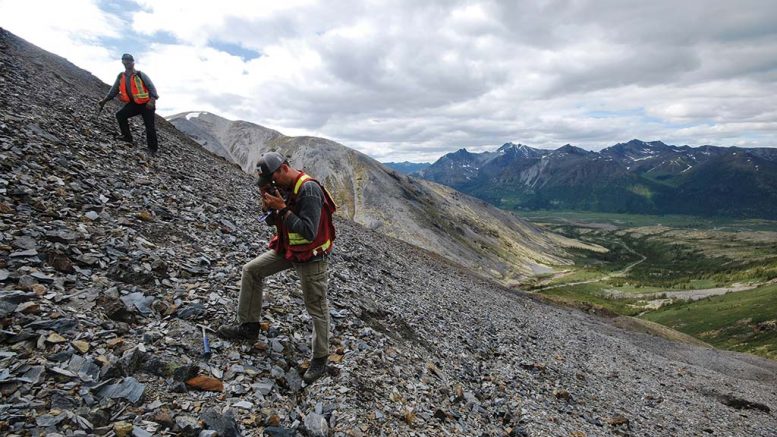Exploration for base metals has taken on a new urgency in the last couple of years, as the electric vehicle revolution proceeds apace, with its need for substantially more copper for wiring, as well as the battery minerals cobalt, lithium, nickel and graphite. Below are seven companies looking for base metals and battery minerals in North America and abroad.
AVALON RARE METALS
Don Bubar-led Avalon Rare Metals (TSX: AVL; US-OTC: AVLNF) is simultaneously developing its Separation Rapids hard-rock lithium deposit, 70 km north of Kenora in northwestern Ontario, and its Nechalacho rare earth element project near Great Slave Lake in the Northwest Territories.
The resource at Separation Rapids as of May 2018 stands at 8.4 million measured and indicated tonnes grading 1.41% Li2O, with another 1.8 million tonnes at 1.35% Li2O in the inferred category.

The surface of Avalon Rare Metals Separation Rapids lithium deposit, 70 km north of Kenora, Ontario. Credit: Avalon Rare Metals.
A preliminary economic assessment in August 2018 envisions a plant throughput rate of 475,000 tonnes per year, compared to the 950,000-tonne yearly rate used in a 2016 study. This would result in a 20-year operating life, with annual production of 71,500 tonnes of petalite concentrate; 11,800 tonnes of lepidolite concentrate (both for 18.5 years); and, beginning in year six, 100,000 tonnes of feldspar (through to year 20). The upfront capital expense requirement is $77.7 million, with another $13.7 million planned for a feldspar circuit in years five to six (or once payback of the initial capital is complete).
Average annual revenue is an estimated $90 million versus average annual costs of $60 million, resulting in a pre-tax net present value (NPV), at an 8% discount rate, of C$156 million, and a 27.1% pre-tax internal rate of return (IRR). The post-tax NPV is calculated at C$102 million and the IRR at 22.7%.
At Nechalacho, Avalon has attracted private Australian company Cheetah Resources to partner in developing the rare earth resources. Avalon and Cheetah signed a binding agreement whereby Cheetah will acquire ownership of the near-surface resources in the T-zone and Tardiff zones for a total cash consideration of C$5 million, while Avalon will retain ownership of the resources in the Basal zone that was the subject of its 2013 feasibility study. Avalon will continue to manage work programs on the property and keep its 3% net smelter return-type royalty.
Avalon is also eyeing small-scale re-development of the past-producing East Kemptville tin mine in Nova Scotia’s Yarmouth County.
DESERT LION ENERGY
Toronto-based, Tim Johnston-led Desert Lion Energy (TSXV: DLI; US-OTC: DSLEF) is developing the first large-scale lithium mine in Namibia, located near Karibib in the Erongo region, within 301 sq. km of prospective land hosting lithium-bearing pegmatitic mineralization.
Desert Lion says the brownfield lithium asset was found and developed in the 1930s, and the property has a history of small-scale mining operations, including the historic Rubicon and Helikon lithium mines.
The company notes the project site is accessible year-round by road with access to power, water, rail, port, airport and communication infrastructure.
Desert Lion is in the first phase of its production plan: producing and exporting lithium concentrate from stockpiled material.
In May 2018, the company said it would cost $7 million to build a flotation plant processing between 350,000 tonnes and 400,000 tonnes of feed per year. The company looks to prove up a resource in an initial range of 10 million to 15 million tonnes grading 1.5% Li2O.
This January, Desert Lion acquires an “Exclusive Prospecting License 5718,” and said it has fulfilled its commitments for the phase-two Mining License (ML204).
FIREWEED ZINC
Fireweed Zinc (TSXV: FWZ; US-OTC: FWEDF) is an explorer and developer focused on advancing its Macmillan Pass zinc project in the Yukon Territory. The project is among the world’s most significant zinc resources, the company says, and is host to the Tom, Jason, Boundary zone and End zone zinc-lead-silver deposits.
In February the company raised $5 million in a non-brokered private placement, including a lead order by strategic investor Teck Resources. Teck’s participation brings its interest in the junior from 4.7% to 9.9%. Fireweed’s largest shareholder, RCF Opportunities Funds, also participated in the offering, acquiring 750,000 shares to keep its 13% stake. The money will be used on exploration and resource expansion at Macmillan Pass.

The Tom camp at Fireweed Zinc’s Macmillan Pass zinc-lead-silver project in the Yukon. Credit: Fireweed Zinc.
A May 2018 preliminary economic assessment outlined an 18-year mine life, with 32.7 million tonnes of mineralized material mined at an average processing rate of 4,900 tonnes per day. The study estimated average yearly contained metal production of 85,000 tonnes zinc, 48,000 tonnes lead and 2 million oz. silver. Pre-production capex was pegged at $404 million, with a four-year payback.
Fireweed completed a resource estimate in January 2018 for the Tom and Jason deposits. Together they contain an indicated resource of 11.2 million tonnes grading 6.59% zinc, 2.48% lead and 21.33 grams silver per tonne for a zinc-equivalent grade of 9.61%. Inferred resources stand at 39.47 million tonnes grading 5.84% zinc, 3.14% lead and 38.15 grams silver per tonne, for a 10% zinc-equivalent grade.
The company’s executive chairman, John Robins, is a geologist and entrepreneur, and before Fireweed was the founder, chairman and director of Kaminak Gold, which discovered the Coffee gold deposits in the Yukon, and was sold to Goldcorp for $520 million.
FIRST COBALT
Led by president and CEO Trent Mell, Toronto-based First Cobalt (TSXV: FCC; US-OTC: FTSST) says it’s the largest cobalt exploration company in the world, and aims to create the world’s “largest pure-play cobalt exploration and development company.”

First Cobalt and US Cobalt personnel on a site visit to the Iron Creek cobalt property in central Idaho. Credit: First Cobalt.
Though it was only formed in early 2017, First Cobalt has already accumulated over 100 sq. km of prospective ground in Ontario’s iconic Cobalt camp, with the company’s Greater Cobalt project comprising land that includes over 50 past-producing mines, a mill, and the only permitted cobalt refinery in North America that makes battery materials.
In Idaho First Cobalt has its newly acquired Iron Creek cobalt project, where in September it updated the inferred resources of 26.9 million tonnes grading 0.11% cobalt equivalent. This compares to the prior historic resource of only 1.2 million tonnes grading 0.59% cobalt.
Former Idaho governor C.L. “Butch” Otter has joined First Cobalt’s board of directors after a long and prominent political career, including both federal and state positions. Otter retired as governor in January following a 12-year tenure, making him the longest consecutively serving governor in the United States.
POWER ORE
Toronto-based Power Ore (TSXV: PORE) was spun out in 2018 as an energy metals junior by Stephen Stewart’s Orefinders Resources, and in a transformative move in December 2018, agreed to buy a full interest in the Opemiska copper mine complex from privately held Explorateurs-Innovateurs de Québec.
Power Ore describes the Opemiska copper mine complex as consisting of two past-producing underground mines in Springer and Perry, and near the town of Chapais, Quebec. Falconbridge operated the Opemiska copper mine complex from 1953 to 1991, when it produced a total of 23 million tonnes at 2.4% copper and 0.3 gram gold per tonne.
Since then, Power Ore has been poring over data at the project, which the junior thinks can be fast-tracked, given its jurisdiction, infrastructure, location and a host of other advantages — possibly as a lower-grade mine, in contrast to its past as a high-grade underground mine.
PUMA EXPLORATION
Rimouski, Quebec-based Puma Exploration (TSXV: PUMA) is a mineral explorer focused on properties in New Brunswick, Canada. Its major assets consist of options to acquire a 100% beneficial interest in the Murray Brook property, the Turgeon zinc-copper project, and the Nicholas-Denys project, all located in the Bathurst Mining Camp.
The Murray Brook deposit is 10 km west of Trevali Mining’s Caribou mine and 10 km east of Trevali’s Restigouche deposit. Murray Brook has a measured and indicated resource dating from December 2016 of 5.28 million tonnes at 5.24% zinc, 1.80% lead, 0.46% copper, 68.9 grams silver per tonne and 0.65 gram gold per tonne, for 610 million lb. contained zinc, 209 million lb. lead and 11.7 million oz. silver.
The core of the resource occurs in the West Zone (zinc-lead), which is 200 metres wide, extending from surface to 300 metres vertical. The true thickness of the massive sulphide body varies from 75 metres to 100 metres. The East Zone (copper-gold) is 100 metres wide, also extending from surface to 300 vertical metres, and is mainly mineralized with gold and copper.
Puma recently reported exploration drill results from Murray Brook, which it says “successfully confirmed the potential to discover additional resources at depth and on the west and south sides on the current known deposit.”
Highlights included drill hole 2018-10 — drilled on the western side of the deposit — which returned 31 metres grading 0.14 gram gold per tonne, 2 grams silver per tonne, 0.02% copper, 0.06% lead and 0.12% zinc from 327 metres downhole. Another hole intersected 322 metres of 0.82 gram gold, 48 grams silver, 0.33% copper, 1.08% lead and 2.09% zinc starting from 15 metres downhole in 2018-12.
Puma also owns an equity interest in BWR Resources, which explores in Manitoba.
VISION LITHIUM
Junior Vision Lithium (TSXV: VLI; US-OTC: ABEPF) is focused on exploring and developing battery mineral assets, including lithium and copper. Nemaska Lithium is the junior’s largest shareholder.
Vision’s flagship project is the Sirmac lithium property, which it acquired from Nemaska Lithium. The project sits 200 km south of Nemaska’s Whahbouchi lithium mine, and is 180 km northwest of Chibougamau.
Vision Lithium started a drill program on the property in April 2018, with 25 shallow holes totalling 1,500 metres targeting the project’s main No. 5 dike outcrop zone. Between 2011 and 2012, Nemaska spent $2 million on exploration work on the No. 5 dike, including 72 shallow drill holes, as well as trenching and sampling.
Last July Vision discovered a mineralized dike more than 5 km from the main No. 5 dike, which it has called the East Zone. The company says there are “at least 12 poorly exposed pegmatite dikes on the property, some of which are known to be lithium-bearing, and most of which have yet to be tested by drilling.” The company has finished a 293 line kilometre airborne MAG survey at the property.
It released results from its exploration programs in November 2018, with diamond drill highlights from the East Zone of 1.36% Li20 over 6 metres from 102 metres downhole in 18-5, and 1.51% Li2O over 1.4 metres from 0.5 metre in 18-1.
The company also owns the Dome Lemieux copper property in Quebec. Dome Lemieux covers 120 sq. km in the Gaspésie region, about 32 km southeast of the town of Sainte-Anne-des-Monts.


Be the first to comment on "Base Metals & Battery Minerals Snapshot: Seven juniors exploring for base metals and battery minerals"